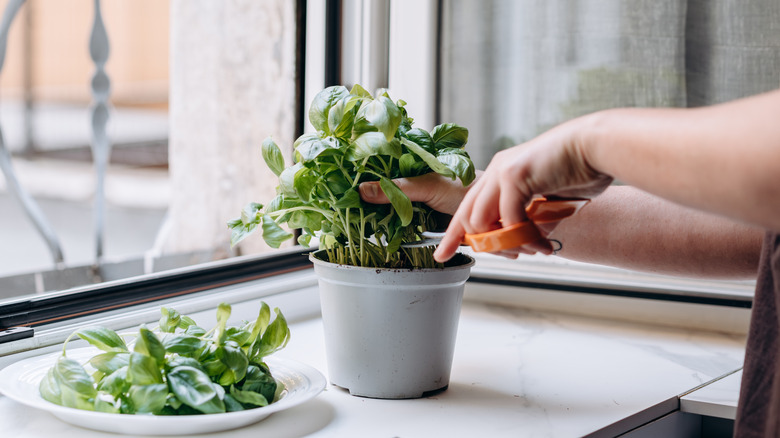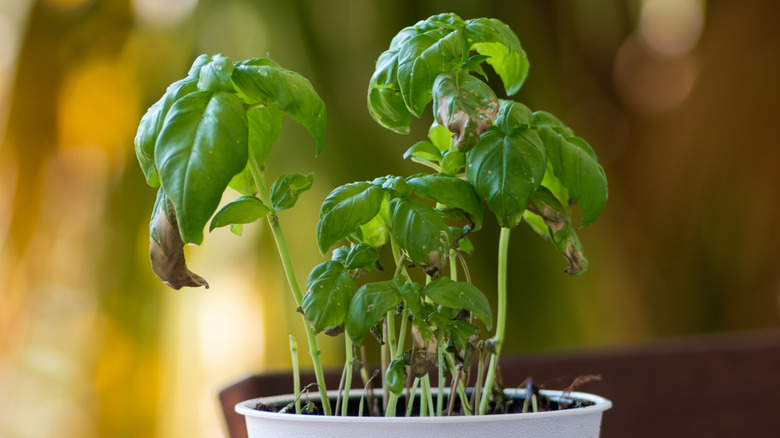The Natural Fertilizer Your Basil Needs Is Sitting In Your Bathroom
If you give your kitchen pantry a quick perusal, one staple you're likely to find is dried basil. There are dozens of varieties of basil (Ocimum basilicum) that flavor cuisines across the world, namely sweet basil in Italian pastas or Thai basil in Asian dishes like pho. While the herb originates from tropical regions of Africa and Asia, it's considered one of the easiest herbs to grow almost anywhere. Basil is a low-maintenance member of the mint family that thrives in partial shade to full sun with good soil drainage, especially in USDA Hardiness Zone 10. However, if you want tips for growing a bountiful basil harvest, consider treating your growing medium with a natural fertilizer commonly found in bathrooms: Epsom salt.
Epsom salt, a colloquial name for the chemical compound magnesium sulfate, is typically used as a bath additive believed to relieve stress and replenish magnesium levels. Various uses of Epsom salt have been examined for over a century, and it is notable for helping to correct magnesium deficiencies in soil. Magnesium is a key component of chlorophyll in plants like basil, and a lack thereof may result in stunted growth. A magnesium deficiency will be apparent via yellow veins at the top of a basil plant, but the quality of your soil can be improved with treatments like Epsom salt as long as you're careful not to overdo things.
How to apply Epsom salt to your growing basil
Being relatively low-maintenance, basil is an easy plant to grow and take care of, and your sprouts should only need to be watered every seven to 10 days with about 1½ inches of water — or more frequently if their potting containers dry out fast. To enrich the soil with more magnesium, it's recommended that you use 1 teaspoon of Epsom salt for a 3-gallon houseplant pot. The easiest way to do this is to mix a solution of 2 1/2 tablespoons per gallon of water, or for large-scale garden, about 1 to 2 pounds of Epsom salt into every 100 gallons of water.
While it's usually best to apply compost and fertilizer to your soil after the season's last frost (and before planting your new crop of seeds), basil showing a magnesium deficiency can be drenched in your Epsom salt solution before switching to a general magnesium-rich fertilizer. This can be repeated every four to six weeks for basil in indoor containers. For plants grown outside in your garden, apply this fertilizer every three to four weeks instead. Basil often requires additional nitrogen to grow quickly, so you should also consider your choice of fertilizer with this in mind.
Too much Epsom salt could spell trouble for basil
Though adding magnesium-rich fertilizer to deficient soil can help your basil grow more lush leaves, you want to be careful not to overuse Epsom salt. For one, too much magnesium can diminish a plant's calcium intake, leading to new problems you'll have to deal with, like root rot. Indoor plants can also develop magnesium toxicity when too much Epsom salt is used in small pots, and different potting mixes can affect how much magnesium is retained. Magnesium deficiency in plants like basil could be a result of soil being leached by watering or rain, in which case water-soluble Epsom salts might not provide much benefit.
You also want to ensure that any fertilizer additives don't affect the soil qualities that would typically help herbs like basil to grow in your kitchen. For example, basil grows best with soil that has a pH range between 6.0 and 7.5, and sulfates from Epsom salt can decrease pH level. An abundance of soluble salts can also result in the soil having higher electrical conductivity, which can lead to poor drainage and structure to support growing plants. While you could drench your magnesium-deficient basil in an Epsom salt solution every four weeks or so, keep an eye on the plant to ensure you aren't going too far in the opposite direction.


